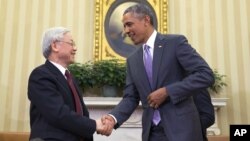U.S. President Barak Obama will visit Vietnam next Monday where trade, security and human rights issues will top the agenda.
Also under discussion will be the possible lifting of a decades-old arms embargo against the Southeast Asian nation.
Meetings with Vietnamese officials will seek to further the US “rebalance” to Asia, where it seeks to extend trade and security relations in the region to counter China’s growing influence on the world stage.
Cambodian officials on Wednesday welcomed the meeting of old enemies, but government spokesman Phay Siphan said that while the visit could “help with reconciliation of their relationship”, the possible easing of the arms embargo was greeted with caution.
“We also heard that the visit will discuss weapons and military issues. Cambodia is a country that prefers building peace, so we don’t support that,” he said.
Hanoi is eager for Obama to lift the embargo, arguing that it is necessary to counter China’s claims on the South China Sea, where the two countries are at loggerheads over overlapping claims to the resource-rich sea.
The Obama administration previously eased the embargo in 2014 by lifting a ban on maritime defense purchases.
Obama also launched the U.S.-Vietnam Comprehensive Partnership in 2013, which seeks to boost trade and security ties between the two countries.
The agreement could also benefit other Asean countries, such as Cambodia, Siphan added.
John Ciorciari, a professor of public policy at the University of Michigan, said that the U.S. was attempting to strengthen ties with a country in the region where its “rebalance” had been working well.
Kung Phoak, president of the Cambodian Institute for Strategic Studies (CISS), said that Cambodia could “also take advantage of this visit, but open discussion involving more countries is needed so that all members can benefit from the Asean Economic Community.”
“For trade cooperation, the more partners the merrier.”
However, Son Chhay, a senior opposition lawmaker, said there was little to be gained from the developments.
“The two main agendas for his visit are trade, military and security. For trade, it’s a special visit as the United States and Vietnam are in the Trans-Pacific Partnership free trade agreement, while Cambodia isn’t,” he said.
Behind the meeting is the shadow of the ongoing South China Sea dispute. China’s claim to large swathes of the sea and the construction of artificial islands and strategic facilities has concerned the U.S. and Vietnam, said Ciorciari.
“The South China Sea is clearly one factor motivating the visit, just as it has been a major driver for the warming of Vietnam-U.S. relations throughout Obama’s presidency,” he said.
He added that multilateral talks were needed to resolve the disputes, something which China has discouraged, preferring direct talks with Asean countries without the mediation of another world power.
Siphan, however, repeated the official Asean position on the dispute – that Asean countries should be allowed to conduct talks without powerful arbiters pulling the strings.
Regarding Cambodia’s own record on human rights, Siphan said that the country was a “step ahead” of U.S. expectations in the region.
Former President Bill Clinton became the first sitting U.S. president to visit the former enemy since hostilities with Vietnam officially ended in 1975.
George W. Bush visited the country during a regional summit in 2006, but his trip was noticeably lower key than his predecessor.









